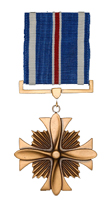*SPECIAL NOTE: This list of Distinguished Flying Cross recipients should not be considered complete. This is an ongoing project and we welcome information on additional Distinguished Service Cross, Silver Star, Distinguished Flying Cross, Soldier’s Medal, Bronze Star with 'V' device, ARCOM with 'V' device, and Air Medal with 'V' device recipients. Please contact us via email.
 The Distinguished Flying Cross was established in the Air Corps Act (Act of Congress, 2 July 1926, Public Law No. 446, 69th Congress). This act provided for award “to any person, while serving in any capacity with the Air Corps of the Army of the United States, including the National Guard and the Organized Reserves, or with the United States Navy, since the 6th day of April 1917, has distinguished, or who, after the approval of this Act, distinguishes himself by heroism or extraordinary achievement while participating in an aerial flight.” The performance of the act of heroism must be evidenced by voluntary action above and beyond the call of duty. The extraordinary achievement must have resulted in an accomplishment so exceptional and outstanding as to clearly set the individual apart from his comrades or from other persons in similar circumstances. Awards will be made only to recognize single acts of heroism or extraordinary achievement and will not be made in recognition of sustained operational activities against an armed enemy.
The Distinguished Flying Cross was established in the Air Corps Act (Act of Congress, 2 July 1926, Public Law No. 446, 69th Congress). This act provided for award “to any person, while serving in any capacity with the Air Corps of the Army of the United States, including the National Guard and the Organized Reserves, or with the United States Navy, since the 6th day of April 1917, has distinguished, or who, after the approval of this Act, distinguishes himself by heroism or extraordinary achievement while participating in an aerial flight.” The performance of the act of heroism must be evidenced by voluntary action above and beyond the call of duty. The extraordinary achievement must have resulted in an accomplishment so exceptional and outstanding as to clearly set the individual apart from his comrades or from other persons in similar circumstances. Awards will be made only to recognize single acts of heroism or extraordinary achievement and will not be made in recognition of sustained operational activities against an armed enemy.
Various designs from the U.S. Mint, commercial artists, and the Office of the Quartermaster General, were submitted to the Commission of Fine Arts and on 31 May 1927, the Commission approved a design submitted by Mr. Arthur E. Dubois and Miss Elizabeth Will. Initial awards of the Distinguished Flying Cross were made to persons who made record breaking long distance and endurance flights and who set altitude records. The Secretary of War authorized the first Distinguished Flying Cross to Captain Charles A. Lindbergh in a letter dated 31 May 1927. With the support of the Secretary of War, the Wright Brothers retroactively received the Distinguished Flying Cross. This award required a special Act of Congress, since the law precluded award to civilians. The current statutory requirements for award of the Distinguished Flying Cross to Army personnel is contained in Title 10, U.S.C., Section 3749; Section 6245 for Navy personnel; and Section 8749 for Air Force personnel. Order of precedence and wear of decorations is contained in Army Regulation 670-1. Policy for awards, approving authority, supply, and issue of decorations is contained in Army Regulation 600-8-22.
AR 600-8-22 updated 5 Apr 2019, slightly changes the criteria for the Distinguished Flying Cross: The DFC, 10 USC 3749, was established by Act of Congress 2 July 1926. The DFC is awarded to any person who, while serving in any capacity with the Army of the United States, distinguished himself or herself by valor, heroism, or extraordinary achievement while participating in aerial flight. The performance of the act of heroism must be evidenced by voluntary action above and beyond the call of duty. The extraordinary achievement must have resulted in an accomplishment so exceptional and outstanding as to clearly set the individual apart from his or her comrades or from other persons in similar circumstances. Awards will be made only to recognize single acts of heroism or extraordinary achievement and will not be made in recognition of sustained operational activities against an armed enemy. When the DFC is awarded for valor on or after 7 January 2016, a bronze letter 'V' (for valor) is worn on the suspension and service ribbon of that medal. The DFC may be awarded with the “C” device to recognize exceptionally meritorious service or achievement per-formed under combat conditions on or after 7 January 2016. See paragraph 6–6 for “C” device criteria.

